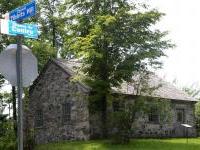 Pioneer schoolhouses were built to accommodate about thirty students from grades one through seven. Most schools were made of wood, with a simple cast-iron wood stove for heating in winter. Outhouses were set apart from the school building or located at the far end of an attached woodshed. There was no electricity for lights, so windows were relied upon for daylight. Until about 1900, when factory-built desks were available, desks and seats consisted of long, hand-hewn pine boards, lined up in rows.
Pioneer schoolhouses were built to accommodate about thirty students from grades one through seven. Most schools were made of wood, with a simple cast-iron wood stove for heating in winter. Outhouses were set apart from the school building or located at the far end of an attached woodshed. There was no electricity for lights, so windows were relied upon for daylight. Until about 1900, when factory-built desks were available, desks and seats consisted of long, hand-hewn pine boards, lined up in rows.
Children had to walk to school, so they would leave home early in the morning. The boys had to do chores when they arrived, like fetching water or bringing in wood for the wood stove. Boys and girls of all ages shared the same classroom.
The school day started with a prayer, a reading from the Bible, and the singing of God Save the Queen. The curriculum consisted of learning the arithmetic tables, spelling, and reading aloud. Enrichment came to those who finished their lessons quickly and listened to the lessons of the older children. School, however, was not compulsory, so work at home often took priority over attendance at school.
Teachers, for their part, were poorly paid and usually rotated from one farm family to another for free room and board.